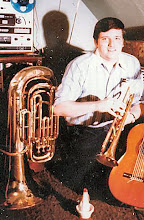Side A:
1. South Rampart Street Parade
2. High Society
3. Margie
4. That's a Plenty
Side B:
1. Jazz Me Blues
2. Lazy River
3. I Am Going Home
4. Farewell Blues
Liner Notes:
As played in the capitol city of jazz by the Basin Street Six
Personnel:
George Girard (trumpet)
Pete Fountain (clarinet, #4 tenor sax)
Joe Rotis (trombone)
Roy Zimmerman (piano)
Bunny Franks (string bass)
Charlie Duke (drums)
Recorded in New Orleans 1950
Dixieland From New Orleans? Naturally. That's where it began back at a time when today's old men were kids in short pants. That's where it first flowed out over the country just before World War I. And that's where most of the best Dixie-land is still coming from. This present record will prove it.
This present record, too, combines the Dixieland of that earlier time with that of the present. It does this through the blend of its personnel. Youths blow the horns of the front line; wise, experienced veterans, with that authentic, old-time beat in their veins, man the rhythm instruments. The Basin Street Six, as the musicians' magazine Down Beat points out, is "strictly a New Orleans born and bred outfit."
Heading the front line is a phenomenal twenty-year old trumpeter and vocalist, George Girard. He leads with his horn, as a Dixieland trumpet must do. With faultless musicianship, Girard's driving style reminds old-timers of the late Paul Mares' commanding horn, while his flow of fresh ideas stamps his playing with a trademark that reads, "Girard, 1950."
Backing George is another youthful phenomenon, the nineteen-year-old clarinetist, Pete Fountain, protege of that unique styled New Orleans "black stick" man, the late Irving Fazola. Pete doubles on a tenor sax, too, that is competently grounded on the style of that New Orleans paragon, Eddie Miller. Fountain's technique and assurance match Girard's and his personal musical ideas pay homage to sound tradition while adding a great deal that is new and his own. George Hoefer, Chicago jazz critic, calls Girard and Fountain "two promising young musicians destined to take their place alongside the New Orleans greats."
Trombonist Joe Rotis completes the horn section with plenty of that timeless parade style known as tailgate. Look for the measure of his taste in the meaningful sparseness of his notes, in the angular, decisive flow of his countermelodic line. Joe knows that the masculine trombone should not talk too much, should make every word count.
Back of all this put a dream rhythm section of men from the town where rhythm was born and who were there when the blessed event was taking place. Bunny Frank's bass is pungent punctuation personified; Roy Zimmerman's piano is that good old, timeless, irreplaceable ragtime; and there are more good-humor, punch and real honest-to-goodness zest in Charlie Duke's drumming than you can find in the whole present hide-beating generation put together.
So it's no wonder that the Basin Street Six and their new-old Dixieland are riding high on the wave of the new Dixieland boom; that they have already conquered Chicago and that their New Orleans following is virtually synonymous with that city's 1950 census figures; that they are already a top national radio attraction; and that they have just started "going places."
Class will tell. Class brought Dixieland back with a bang to a public weary of music without melody, music without honest, unashamed feeling. Dixieland is coming back home into the heart of the people. And class puts the Basin Street boys at the head of that syncopated, homeward wending parade.
Wednesday, November 28, 2007
Dixieland From New Orleans: The Basin Street Six - Circle Sound Records
Dixieland From New Orleans
The Basin Street Six
Subscribe to:
Post Comments (Atom)





No comments:
Post a Comment